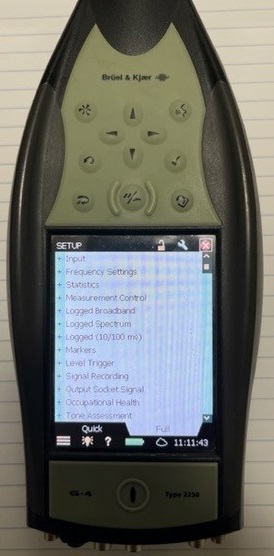
Predicting Interior Noise Levels
November 20, 2019
Why Do We Need Noise Studies?
December 13, 2019Sound Level Meters
Let’s take a look at the type of instruments used to measure noise, generically referred to as sound level meters. For professional purposes, precision Type 1 meters (such as those manufactured by Brüel & Kjær or Larson Davis) are usually used. Precision meters are calibrated by the manufacturer and periodically returned for recalibration. They are also field calibrated before and after a measurement to make sure there has been no “drift” during the measurement.
A spectrum analyzer or 1/3-octave band analyzer is another kind of meter, used to analyze the component frequencies of a measured sound to determine the predominant frequencies and/or to detect the presence of a tone.
We usually need to know the average sound level measured, Leq, and often need further analysis for tiered noise ordinances (see A Look At Environmental Noise Part II: Nuisance Factors and Noise Ordinances) so that we know what level was exceeded for the specified cumulative period (5 minutes, 10 minutes, etc.). Modern sound level meters have the ability to integrate sound levels and provide the statistical data we require at the touch of a button at any time during or after a measurement, and can store the data to be downloaded directly into a computer program later.
First, you need to understand the nature of the sound you wish to measure. Sound level meters have built-in frequency weighting filters, as discussed in A Look at Environmental Noise Part I: Some Basics on Noise and Weighting Filters. The A-weighting filter is the one most commonly used in environmental noise studies. The C-weighting filter is used to detect low frequency noise levels (typically, from rotating machinery), and the D-weighting filter is used for high frequencies (notably aircraft noise).
Second, you need to know whether the noise you want to measure is impact (sudden) noise, or consists of a constant sound. The root-mean-square, RMS, detector in the meter can be set to fast or slow response. Fast response is the setting used to measure levels of short-lived sounds. Slow response provides much smoother data but without losing anything.
We usually need to know the average sound level measured, Leq, and often need further analysis for tiered noise ordinances (see A Look At Environmental Noise Part II: Nuisance Factors and Noise Ordinances) so that we know what level was exceeded for the specified cumulative period (5 minutes, 10 minutes, etc.). Modern sound level meters have the ability to integrate sound levels and provide the statistical data we require at the touch of a button at any time during or after a measurement, and can store the data to be downloaded directly into a computer program later.
Choosing the Right Settings
First, you need to understand the nature of the sound you wish to measure. Sound level meters have built-in frequency weighting filters, as discussed in A Look at Environmental Noise Part I: Some Basics on Noise and Weighting Filters. The A-weighting filter is the one most commonly used in environmental noise studies. The C-weighting filter is used to detect low frequency noise levels (typically, from rotating machinery), and the D-weighting filter is used for high frequencies (notably aircraft noise).
Second, you need to know whether the noise you want to measure is impact (sudden) noise, or consists of a constant sound. The root-mean-square, RMS, detector in the meter can be set to fast or slow response. Fast response is the setting used to measure levels of short-lived sounds. Slow response provides much smoother data but without losing anything.

Practical Tips for Measurements





